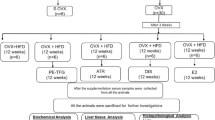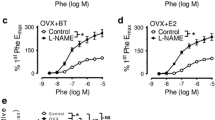Abstract
Background
Obesity and dyslipidemia due to estrogen deficiency are among the important health problems in menopausal women. Increasing evidence reports the anti-obesity and anti-hyperlipidemic properties of tea polyphenols. However, the effect of white tea (WT) with high polyphenol content on overweight and lipid profile is uncertain. Here, we aimed to examine the effects of long-term WT consumption on serum leptin, tumor necrosis factor- alpha (TNF-α) and uncoupling protein 1 (UCP1) mRNA gene expression in ovariectomized (OVX) rats.
Methods
Adult rats were divided into four groups (n = 8): (i) sham, (ii) OVX, (iii) WT and (iv) OVX + WT. WT was given at a dose of 0.5% w/v for 12 weeks. In the study, body weight, serum leptin, TNF, estradiol (E2) levels, lipid profile and UCP1 mRNA gene expression in brown adipose tissue (BAT) were evaluated.
Results
There was a significant increase in body weight of OVX rats, which was decreased following WT consumption. While leptin and E2 levels decreased in the OVX group, TNF levels increased. There was no difference between the NF-κB levels of the groups. In addition, BAT UCP1 mRNA expression was significantly decreased in OVX groups, while WT treatment stimulated UCP1 activity.
Conclusion
We explain the stimulatory effect of WT on weight loss mainly by the induction of UCP1 gene-mediated thermogenesis and suppression of inflammation. Therefore, we suggest that prolonged WT consumption may have beneficial effects in limiting excess weight gain caused by estrogen deficiency.
Similar content being viewed by others
References
Rosano GMC, Vitale C, Marazzi G, Volterrani M. Menopause and cardiovascular disease: the evidence. Climacteri 2007; 10: 19–24.
Gravena AAF, Brischiliari SCR, Lopes TCR, Agnolo CMD, Carvalho MDB, Pelloso SM. Excess weight and abdominal obesity in postmenopausal Brazilian women: a population-based study. BMC Womens Health 2013; 13(1):46.
Litwak SA, Wilson JL, Chen C, et al. Estradiol prevents fat accumulation and overcomes leptin resistance in female high-fat diet mice. Endocrinology 2014; 155(11):4447–60.
Freeman EW, Sammel MD, Lin H, Gracia CR. Obesity and reproductive hormone levels in the transition to menopause. Menopause 2010; 17(4):718–26.
Lizcano F, Guzmán G. Estrogen deficiency and the origin of obesity during menopause. Biomed Res Int 2014; 2014: 1–11.
Mauvais-Jarvis F, Clegg DJ, Hevener AL. The role of estrogens in control of energy balance and glucose homeostasis. Endocr Rev 2013; 34(3):309–38.
Van Marken Lichtenbelt WD, Vanhommerig JW, Smulders NM, et al. Cold-activated brown adipose tissue in healthy men. N Engl J Med 2009; 360(15):1500–8.
Fedorenko A, Lishko PV, Kirichok Y. Mechanism of fatty-acid-dependent UCP1 uncoupling in brown fat mitochondria. Cell 2012; 151(2):400–13.
Pedersen SB, Bruun JM, Kristensen K, Richelsen B. Regulation of UCP1, UCP2, and UCP3 mRNA expression in brown adipose tissue, white adipose tissue, and skeletal muscle in rats by estrogen. Biochem Biophys Res Commun 2001; 288(1):191–7.
Kanamoto Y, Yamashita Y, Nanba F, et al. A black soybean seed coat extract prevents obesity and glucose intolerance by up-regulating uncoupling proteins and down-regulating inflammatory cytokines in high-fat diet-fed mice. J Agric Food Chem 2011; 59(16):8985–93.
Arias N, Picó C, Teresa Macarulla MM, et al. A combination of resveratrol and quercetin induces browning in white adipose tissue of rats fed an obesogenic diet. Obesity 2017; 25(1):111–21.
Shi C, Zhu L, Chen X, et al. IL-6 and TNF-α induced obesity-related inflammatory response through transcriptional regulation of miR-146b. J Interf Cytokine Res 2014; 34(5):342–8.
Siebert C, Bertó CG, Ferreira FS, Moreira DS, Marcon Dos Santos T, Wyse ATS. Vitamin D partially reverses the increase in p-NF-κB/p65 immunocontent and interleukin-6 levels, but not in acetylcholinesterase activity in hippocampus of adult female ovariectomized rats. Int J Dev Neurosci 2018; 71: 122–9.
Valladares A, Roncero C, Benito M, Porras A. TNF-α inhibits UCP-1 expression in brown adipocytes via ERKs — opposite effect of p38MAPK. FEBS Lett 2001; 493(1):6–11.
Ohishi T, Goto S, Monira P, Isemura M, Nakamura Y. Anti-inflammatory action of green tea. AntiInflamm AntiAllergy Agent Med Chem 2016; 15(2):74–90.
Huang J, Wang Y, **e Z, Zhou Y, Zhang Y, Wan X. The anti-obesity effects of green tea in human intervention and basic molecular studies. Eur J Clin Nutr 2014; 68(10):1075–87.
Rains TM, Agarwal S, Maki KC. Antiobesity effects of green tea catechins: a mechanistic review. J Nutr Biochem 2011; 22(1):1–7.
Suzuki T, Pervin M, Goto S, Isemura Mamoru, Nakamura Y. Beneficial effects of tea and the green tea catechin epigallocatechin-3-gallate on obesity. Molecules 2016; 21(10):5–8.
Li F, Gao C, Yan P, et al. EGCG reduces obesity and white adipose tissue gain partly through AMPK activation in mice. Front Pharmacol 2018; 9: 1–9.
Nomura S, Ichinose T, **de M, Kawashima Yu, Tachiyashiki Kaoru, Imaizumi, Kazuhiko. Tea catechins enhance the mRNA expression of uncoupling protein 1 in rat brown adipose tissue. J Nutr Biochem 2008; 19(12):840–7.
Saral S, Dokumacioglu E, Mercantepe T, et al. The effect of white tea on serum TNF-α/NF-κB and immunohistochemical parameters in cisplatin-related renal dysfunction in female rats. Biomed Pharmacother 2019; 112: 108604.
Teixeira LG, Lages PC, Jascolka TL, et al. White tea (Camellia sinensis) extract reduces oxidative stress and triacylglycerols in obese mice. Food Sci Technol 2012; 32(4):733–41.
Pfaffl MW. A new mathematical model for relative quantification in real-time RT-PCR.. Nucleic Acids Res 2001; 29(9):e45.
Clegg DJ. Minireview: the year in review of estrogen regulation of metabolism. Mol Endocrinol 2012; 26(12):1957–60.
Witte MM, Resuehr D, Chandler AR, Mehle AK, Overton J. Female mice and rats exhibit species-specific metabolic and behavioral responses to ovariectomy. Gen Comp Endocrinol 2010; 166(3):520–8.
Tsai YC, Leu SY, Chen SY, et al. 17-DMAG, an Hsp90 inhibitor, ameliorates ovariectomy-induced obesity in rats. Life Sci 2019; 232: 116672.
Zang H, Rydén M, Wåhlen K, Dahlman-Wright K, Arner P, Lindén Hirschberg A. Effects of testosterone and estrogen treatment on lipolysis signaling pathways in subcutaneous adipose tissue of postmenopausal women. Fertil Steril 2007; 88(1):100–6.
Zhang L, Li N, Ma ZZ, Tu P-F. Comparison of the chemical constituents of aged pu-erh tea, ripened pu-erh tea, and other teas using HPLC-DAD-ESI-MSn. J Agric Food Chem 2011; 59(16):8754–60.
Lee MS, Shin Y, Jung S, Kim Y. Effects of epigallocatechin-3-gallate on thermogenesis and mitochondrial biogenesis in brown adipose tissues of diet-induced obese mice. Food Nutr Res 2017; 61(1):1325307.
Pantaleão TU, Mousovich F, Rosenthal D, Padrón AS, Carvalho DP, Corrêa da VM, Costa. Effect of serum estradiol and leptin levels on thyroid function, food intake and body weight gain in female Wistar rats. Steroids 2010; 75(10): 638–42.
Yin C, Kang L, La C, et al. Effects of 17β-estradiol on leptin signaling in anterior pituitary of ovariectomized rats. Exp Anim 2016; 66(2):159–66.
Chu SC, Chou YC, Liu JY, Chen CH, Shyu JC, Chou FP. Fluctuation of serum leptin level in rats after ovariectomy and the influence of estrogen supplement. Life Sci 1999; 64(24): 2299–306.
Fazliana M, Wan Nazaimoon WM, Gu HF, Ostenson C-G. Labisia pumila extract regulates body weight and adipokines in ovariectomized rats. Maturitas 2009; 62(1):91–7.
Pfeilschifter J, Köditz R, Pfohl M, Schatz H. Changes in proinflammatory cytokine activity after menopause. Endocr Rev 2002; 23(1):90–119.
Cioffi M, Esposito K, Vietri MT, et al. Cytokine pattern in postmenopause. Maturitas 2002; 41(3):187–92.
Abu-Taha M, Rius C, Hermenegildo C, et al. Menopause and ovariectomy cause a low grade of systemic inflammation that may be prevented by chronic treatment with low doses of estrogen or losartan. J Immunol 2009; 183(2):1393–402.
Nisoli E, Briscini L, Giordano A, et al. Tumor necrosis factor a mediates apoptosis of brown adipocytes and defective brown adipocyte function in obesity. Proc Natl Acad Sci USA 2009; 97(14):8033–8.
Wu AH, Spicer D, Stanczyk FZ, Tseng C-C, Yang CS, Pike MC. Effect of 2-month controlled green tea intervention on lipoprotein cholesterol, glucose, and hormone levels in healthy postmenopausal women. Cancer Prev Res 2012; 5(3):393–402.
** D, Xu Y, Mei X, et al. Antiobesity and lipid lowering effects of theaflavins on high-fat diet induced obese rats. J Funct Foods 2012; 5(3):1142–50.
Acknowledgement
This study was funded by the RTE University Scientific Project Support Office (RTEUBAP, Project No: TSA-2017-816). We would like to thank the General Directorate of tea enterprises (CAYKUR) for the supply and analysis of tea samples.
Author information
Authors and Affiliations
Corresponding author
Additional information
Compliance with Ethical Standards
Ethics committee approval of the present study was obtained from the Experimental Animals Local Ethics Committee of RTE University (Protocol No: 2017/28).
About this article
Cite this article
Saral, S., Saydam, F., Dokumacioglu, E. et al. Effect of white tea consumption on serum leptin, TNF-α and UCP1 gene expression in ovariectomized rats. Eur Cytokine Netw 32, 31–38 (2021). https://doi.org/10.1684/ecn.2021.0467
Published:
Issue Date:
DOI: https://doi.org/10.1684/ecn.2021.0467




